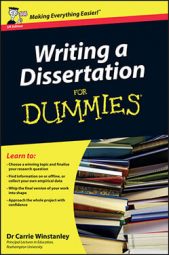Having to write a dissertation proposal depends upon the university or institution that you’re attending. Even if a dissertation proposal isn’t a requirement, however, it’s a very useful exercise (and is certainly going to impress your supervisor, especially if it’s not part of your assessment).
On some courses the research proposal is assessed and forms part of your final dissertation submission. If this is the case, it’s vital that you follow the correct format and submit your work on time. Mostly, a dissertation proposal has a 500 or 1,000 word limit, but you must check what your course specifically requires.
What is a dissertation proposal?
A dissertation proposal is basically a description of the following:
What your dissertation is about
Probable questions that you’re going to be examining
Some reference to the theoretical background
Research methods you’re going to be using (empirical or non-empirical)
Potential outcomes of the study
Time spent putting your dissertation proposal together is an investment. You reap rewards because the proposal stops you wasting time and also forms the basis of your dissertation outline.
Writing a dissertation proposal, even if it’s not a requirement, is still worth doing. You can submit the proposal to your supervisor (with her agreement) and get some valuable feedback.
Ask your supervisor for guidance about the tone and style of your research proposal. You need to be flexible and open-minded, showing a willingness to adapt your methods and ideas as your research dictates. Say in your proposal what you intend to do, confidently and adopting a balanced view, suggesting that you’ve carefully considered the best way of carrying out your study. Be firm but not arrogant; be flexible but not feeble!
Make sure that you follow the rules of grammar in your proposal. Be consistent about the tense of your proposal. Most proposals are written using the future tense: ‘I will be using questionnaires . . . and so on’. Check with your supervisor for confirmation.
What does a dissertation proposal include?
The essential parts of a research proposal are generally standard:
Dissertation title (so far): Aim at making the title short and to the point.
Overall objectives: If you have more than three objectives, your area of research is probably far too broad and needs to be narrowed. (Some university courses may ask you to include a rationale at this stage.)
Literature, context, background: You can use any of these words as the title of this section, just make sure that you mention key schools of thought or areas of study that are going to provide information about your dissertation. (Some proposals require you to list specific references at this point, others ask for the bibliography at the end.)
Details of the research: Here, you can expand the ideas spelt out in your research question. This section is about outlining clearly your area of research.
Methodologies: Your work may be empirical (with some sort of study and collection of data such as questionnaires) or non-empirical (no such data, all your research comes from already published writing and projects). If your study is non-empirical, this section is likely to be short; longer if you need to collect or look at the empirical data.
If you’re allowed to use bullet points in your research proposal, you need do no more than list your intended activities (for example, carrying out interviews, consulting archives or evaluating data).
Potential outcomes: Avoid second-guessing the result of your dissertation. If you knew the outcomes, it would be pretty pointless doing the dissertation! Here, you’re summarising the type of outcomes you hope to generate and suggesting a target audience.
Timeline: If you’re asked to outline how you plan to manage your research, think about including a Gantt chart or some kind of concept map. Whatever you do, make your timeline realistic.
Bibliography: Check if you’re required to provide a list of references, and if so, find out roughly how many references you’re expected to list.

